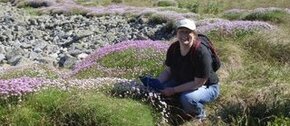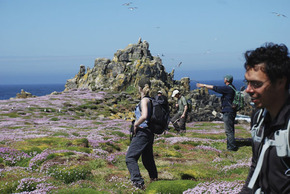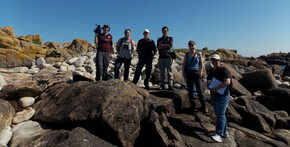Seabird population trends in Scilly
Seventeen species of seabird have been reliably documented as breeding on the Isles of Scilly: Manx shearwater, fulmar, storm petrel, shag, cormorant, great black-backed gull, lesser black-backed gull, herring gull, kittiwake, common tern, Arctic tern, roseate tern, sandwich tern, puffin, razorbill and guillemot (there are also three records of breeding by black-headed gull involving one or two pairs in late 18 and early 19 century but not since). Today thirteen species regularly breed. Fulmar has colonised the islands and sandwich tern, Arctic tern and roseate tern are now lost as breeding birds. The fortune of the kittiwake also remains in the balance and it could too soon be lost as a breeding bird on the islands once again.
Early accounts indicate that at least in the 1800’s the numbers of seabirds breeding on the islands were substantially higher than today with the overall seabird population potentially running into 100,000’s of birds. From 1969 onwards there have been four major co-ordinated seabird counts on the islands. Today the overall population is fewer than 20,000 seabirds on the islands, and still declining (25% since 1983). The four regularly breeding species of gull and the common terns have shown the largest recent declines of any species.
Since 2006 in addition to regular counts on some islands such as Annet, productivity monitoring has been carried out on a sample of species and islands.
Seabird surveys across the islands were carried out again in 2015 by seabird ecologist Dr Vickie Heaney and her team. You can read the summary of the report and the updated seabird numbers on St Agnes and Gugh here and the full report here.
A brief summary of the status of the seabirds breeding on Scilly (2006).
|
Species |
Breeding pairs 2006 |
% change since SPA baseline |
Long-term Trends |
|
Fulmar |
279 |
53% |
Continued massive increases since first breeding in 1951 |
|
European shag |
12961 |
17% |
Recent increase after a slow reduction in numbers through the 1980s and 1990s; still 30% more pairs than in 1969 |
|
Razorbill |
342 |
16% |
Increased by 117% since the mid 1980s |
|
Great black-backed gull |
901 |
12% |
Recent upturn after a general decline, (down 43%) since the mid 1970s |
|
Atlantic puffin |
174 |
4% |
70% increase since the 1980s, but there is some difficulty in comparing counts |
|
Sandwich tern |
1 |
n/a |
Only an occasional breeder |
|
European storm petrel |
13981 |
-5% |
Numbers appear relatively stable, though possibly a slight decrease2 |
|
Black-legged kittiwake |
266 |
-6% |
Continued decrease, reduced by 70% since 1983, and only 19% of the 1969 numbers present in 2006 |
|
Lesser black-backed gull |
33351 |
-8% |
Continued slow decrease, down 18% since a peak of 4050 pairs in 1983 |
|
Great cormorant |
50 |
-11% |
Fluctuates around 50-60 pairs |
|
Manx shearwater |
171 |
-15% |
Apparent recent decrease2 |
|
Common tern |
78 |
-19% |
Continued decrease, down 63% since a peak of 210 pairs in 1983, however an increase on the 2005 count of 67 pairs |
|
Common guillemot |
155 |
-21% |
Recent decrease after a steady rise in numbers; breeding numbers have trebled since 1969 |
|
Herring gull |
715 |
-21% |
Continued steep decline; a 68% reduction in population since 1974 |
1Represents >10% of overall breeding assemblage (great black-backed gull now 9.8%).
2Based on only two counts using comparable (tape-playback) methods.
Surveys
31st May 2013: The annual seabird count on Annet took place today, led by Dr Vickie Heaney on behalf of the Isles of Scilly Wildlife Trust and IOSSRP. Jaclyn and Bob joined volunteers Darren, Matt, Julian and Colin. It was good that the weather was not too hot as this meant the impact of disturbance was kept to a minimum.
1st June 2013: On Gugh, Bob assisted Dr. Vickie Heaney with surveys of the Manx shearwater burrows on the island. Several occupied burrows were found, and one was suitable for a trial using one of our new trail cameras. Careful placement means that birds are able to land and approach the burrow unhindered – very important when you have to shuffle like a shearwater - and can also take off safely when leaving. Let’s hope we get some images of shearwaters and not rats!


Ecologists monitoring seabird populations

Volunteers assisting surveys
















